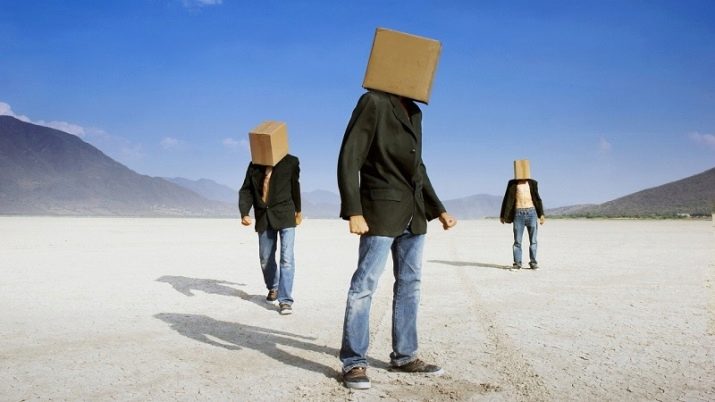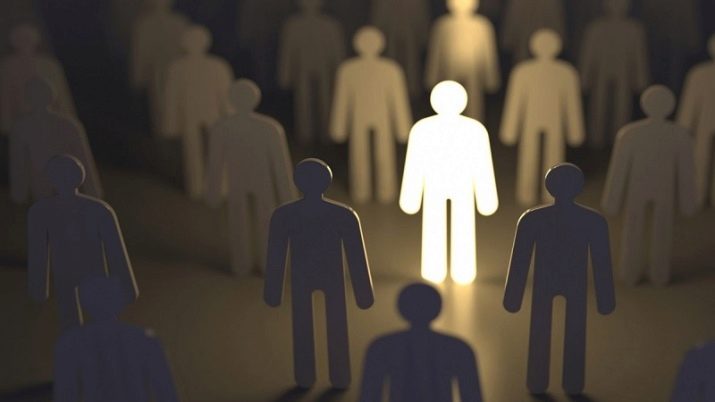Stereotypical thinking: features, types and tips for getting rid

Every person every day is faced with stably repeating actions, stamped phrases and stereotyped decisions that prevent the individual from thinking out of the ordinary and feeling his own self-sufficiency. Stereotyped thinking often distorts reality, alters the scheme of perception of the environment and prevents the emergence of new original images.
What it is?
Stereotypical thinking is formed as a result of excessive sensitivity of concepts and perceptions imposed by the media and the outside world. The child is taught from birth to standard actions. Each person with their own non-trivial views is individual and unique. But people from childhood are limited by far-fetched norms, driven into a certain framework. Laying down templates, ready-made clichés, deprives them of the opportunity to make extraordinary decisions.
For most people, stereotypes become the basis of mental activity. They begin to constantly use the well-established clichés and cliches, apply them in all situations, generalizing the world around them.
This type of thinking is referred to as a disorder of the thought process, because thinking stereotypically means monotonous.

The stereotyped thinking is that the individual divides everything that happens in the world into correct and incorrect information... The stereotyped perception of the environment causes hostility to other opinions. People who think stereotypes perceive the value and correctness of their thoughts and attitudes. They do not perceive judgments that differ from their beliefs. The stereotype becomes a model to be followed.
Established public opinion affects the mind of the individual. Stereotypes hinder an objective perception of the world. A person evaluates any event through the prism of prejudices, prejudices, standards. Fixed views have a big impact on people. They show the same reaction in similar situations. The stereotype does not carry any useful force. Often it is negative in nature and is aimed at ridiculing the habits, characteristics of people, and their opinions.
A person's perception occurs according to one of the signs, his individual characteristics are not taken into account... The basis is taken by profession, appearance, nationality, age, gender. For example, all medical workers are callous personalities, all gypsies are thieves and deceivers, handsome men always cheat on their wives. The stereotypical nature of thinking does not even allow one to think that in reality there are many people who do not correspond to the pasted labels.
Stamped images are found in various areas of life: a difficult teenager, a weak woman, a strict boss, a drunken deputy, an unkempt bachelor, a dishonest salesman. Patterned thinking generates reference models of actions.
People who think in certain cliches are easy to control. It is easy for them to instill and impose an idea. They are not exclusive.

Origin mechanism
An individual who has no experience in a particular issue, listens to public opinion and trusts stereotypes. Society introduces into the consciousness of a person some image of judgments, thoughts. Stamped phrases like “there is no ordinary friendship between a woman and a man”, “all guys want only sex from girls”, “all the secretaries are the boss’s mistresses”, “old people always grumble”, “men never cry” begin to take hold in my head. On the one hand, well-established stereotyped ideas about the world help a person to exist in a social environment, on the other hand, they generate stereotypical thinking, often with destructive effects.
The mechanism of the emergence of patterned mental activity lies in the received experience of the past. A person learns standard schemes, a simplified understanding of the environment. The fixed result is passed on from generation to generation. It takes root in the minds of people, takes root in society. The experience of an individual person can become a social model of society's behavior.

Types
Stereotypes usually reflect the individual's ideas about himself or about the people around him, about another social group. The standard of the act of thought has many varieties.
- Polar (black and white) thinking does not allow any compromise in dividing the world into good and bad phenomena and events.
- Catastrophic is seen in any future events, the future is presented in gloomy tones and is characterized by extremely negative forecasts.
- Depreciation all positive emotions are in focus solely on their own failures and inability to notice positive phenomena.
- Selective thinking allows us to isolate only failure and negative events from everything that has happened to an individual.
- Emotional surge able to inspire a person's confidence in the formulaic thoughts caused by his feelings.
- Tagging on the people around it is to create a stereotype in relation to a particular person or certain social groups.
- Over-generalization events leads the individual to the belief that negative experiences will always manifest themselves in similar situations.
- Personalization manifests itself in the reception at his own expense of any negative statements of others, exposing his own person as the cause of all troubles.
- Tunnel Thinking forces the individual to notice some disadvantages, and ignore the pros.
- Minimizing way of thinking he perceives all positive phenomena negatively.
- The conviction that others are obliged act according to the given templates, deviation from which is not allowed.

What does it lead to?
Stereotypical thinking aims to simplify the thought process, because a person does not need to strain their brains. It is much easier to think with certain cliches rooted in consciousness. Templates and clichés form a simplified representation of the surrounding objects and phenomena. There is a predictability of a person's further actions, the possibility of modeling his behavior.
Stereotyped thinking leads to a loss of individuality. A person adapts to a certain model of behavior, looks up to some kind of model. This leads to depersonalization of others, which interferes with building full-fledged relationships.
The stereotype of the thought process contributes to the awakening of fear due to the fear of condemnation of actions or words by the people around. A person is afraid to perform any action that runs counter to generally accepted ideas. He is afraid to express his opinion once again, so as not to lose the approval and recognition of the society.

How to get rid of?
Breaking stereotypes is much more difficult than creating them. It can be difficult for people to abandon an opinion rooted in society and decide on an innovation. To implement the destruction of stereotyped thinking you need to get rid of the standard train of thought. A gradual withdrawal from the existing stereotyped thought process helps the personality to reveal itself to a greater extent. Letting go of prejudice brings joy to life. Thanks to this, the ability to perceive the friendliness of people and the attractiveness of the world is formed. To free yourself from stereotyped thinking, it is important to take a number of actions.
Perceive the world around you without judging. Labeling limits individual freedom. Learn to observe the people around you without comment. Try to get rid of obsessive beliefs like "all blondes are naturally stupid", "all men are prone to cheating," and "unmarried women are lonely and unhappy." Learn to notice their good qualities in people, do not look for negative sides in them. Try to find a flavor in every person you meet on your way. Do not reject people who belong to a different cohort or are in any way different from you.
Develop the ability to accept the opposite point of view, even if it does not fit into your ideas in any way. Develop tolerance for other people's opinions. Anyone can defend their own positions and judgments.
Don't judge a whole group of people by one individual. You can stop communicating with a bad person, but abandon the prejudice against the society of which he is a part.

Do not listen to the opinion imposed on you from the outside. A person free from stereotypes will not tell you what you should do and what you should give up. Do not believe gossip, rumors, slander. They often contain false information. Trust your sixth sense, intuition. Reassure yourself that no one needs your approval. All people are different and they can behave the way they like. Accept this fact, try to mentally put yourself in their place.
Control your movements. Look for standard and originality among them. The search for stereotypes and originality in their own actions helps to destroy many common stereotypes. Broaden your horizons. Explore new cultures, communicate with people of different national and religious backgrounds. Fresh thoughts and new knowledge contribute to a change in outlook on life. They do not completely eliminate the use of cliches and clichés, but they significantly expand the boundaries of the thought process.
Treat any reality as new and unique.Develop the skill of transforming criticality into self-criticism. Look for hidden perfection not only in those around you, but also in yourself.

Meditate
Meditations help to look at the situation from the outside, free the mind from outside influences. A person has the opportunity to reason in a calm atmosphere, to rid his mind of obsessive stereotyped ideas.
Control your own thoughts
Leads to such control the ability to listen to the inner voice. Ignore the imposition of negative facts and information, which are based on panic and fear. Get rid of your own assessments and categorical judgments. Train your mental flexibility. Controlling your own thoughts helps you focus on thinking and abstract from stereotypes. Reasoning left unconsciously is subject to stereotyped influence.
Ask yourself "why am I doing this?" and why?"
Such questions enable a person to look at the situation from the outside and soberly assess it. They contribute to the recognition of the problem, attempts to correct the situation and self-development. You need to develop the habit of asking yourself a variety of questions: "What does this offense give me?", "Why do I avoid such situations?", "Why do I want to experience such emotions?"
Conscious answers to questions make it possible to see the motives of their actions, help to overcome many stereotypes.









